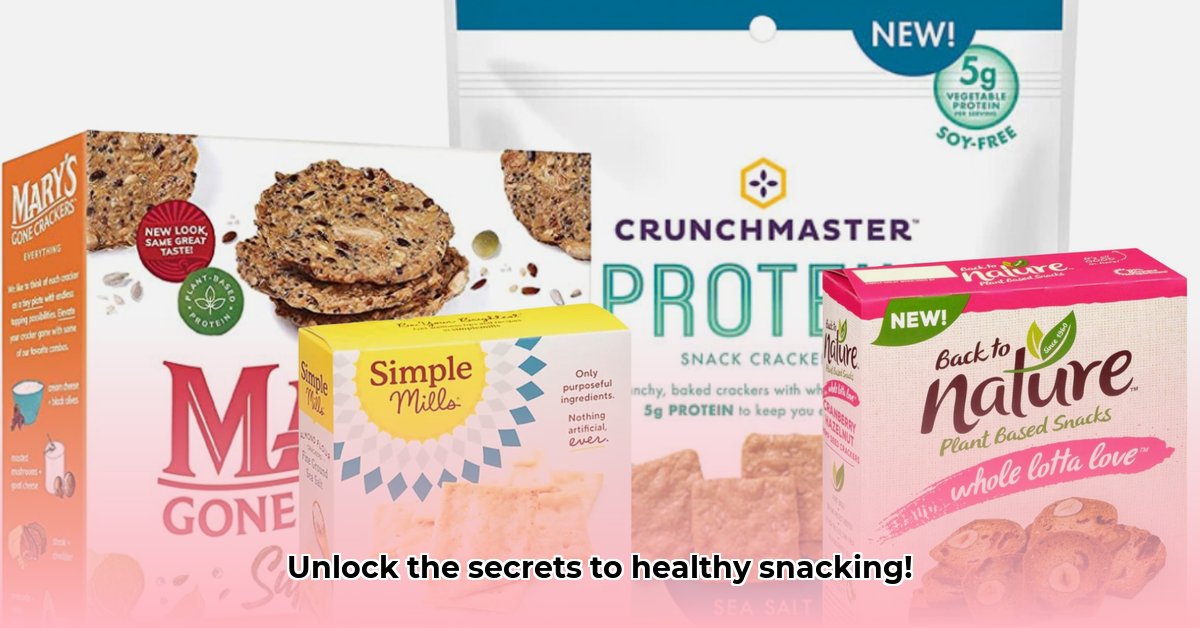Picking the right crackers can be tricky! So many choices, so many confusing labels. This guide cuts through the noise and shows you how to find healthy and delicious crackers. We’ll compare different brands, explain what to look for on the package, and give you simple tips to make smart snack choices every time. Let’s make snack time easier and healthier! For more detailed information, check out this [comprehensive guide](https://chaztin.com/healthy-crackers/).
What Are Healthy Crackers to Eat? Understanding the Basics
So, you’re craving a crunchy snack, but you also want to make healthy choices. Finding the perfect cracker can feel like a rewarding quest when you know what to look for! Instead of just grabbing any box off the shelf, consider crackers as a vehicle for delivering nutrients and complementing other healthy foods. The best choices offer a balance of taste and nutritional value.
Think about what you want from a cracker. Are you looking for a low-sodium option to pair with flavorful cheeses? Or perhaps a high-fiber choice to keep you feeling full between meals? Maybe you need a gluten-free option that doesn’t compromise on taste and texture? Defining your needs is the first step.
Decoding the Cracker Label: Your Comprehensive Guide
Forget fancy packaging – the real key to finding healthy crackers lies in understanding what’s inside the box. The nutrition label is your best friend, so let’s learn how to read it like a pro. This isn’t just about scanning numbers; it’s about empowering yourself to make informed decisions.
-
Serving Size Sanity Check: Always start here! The nutrition information is based on the listed serving size. Don’t compare crackers based on package alone, or you’ll be mislead.
-
Fiber: The Champion of Fullness: Aim for at least 3 grams per serving, but ideally 4 or more. Fiber is indigestible plant matter that promotes satiety, regulates blood sugar, and supports healthy digestion. It’s a nutritional powerhouse that keeps you feeling satisfied longer.
-
Sodium: The Sneaky Salt Source: Keep an eye on the sodium – ideally, under 140 milligrams per serving. High sodium intake is linked to high blood pressure and other health problems. Be especially mindful if you’re sensitive to salt or have any underlying health conditions.
-
Added Sugar: The Hidden Culprit: Added sugars are the empty-calorie bandits that sneak into foods under various names. Common aliases include corn syrup, fructose, dextrose, and sucrose. Before you buy, scan the ingredients list. Choose items with less than 2 grams per serving, but ideally zero added sugar.
-
Fat Content: Focus on Type, Not Just Quantity: While crackers aren’t generally high in fat, pay attention to the type of fat. Limit saturated and trans fats, and opt for crackers made with healthier unsaturated fats like olive oil or avocado oil.
-
Whole Grains: The Foundation of Nutrition: Look for “100% whole grains” as a key ingredient – such as whole wheat, whole oats, or brown rice. These provide more fiber, vitamins, and minerals compared to refined grains. Make sure “whole wheat flour” (or other whole grain) is the first ingredient listed.
-
Ingredient Sleuth: Simplicity is Key: The simpler the ingredient list, the better. Fewer ingredients usually mean fewer additives, preservatives, and artificial flavors. Think of it as a sign of a less processed food.
Healthy Cracker Face-Off: A Detailed Nutritional Comparison
The nutritional content varies significantly between different brands. Let’s examine a few popular choices, keeping in mind that serving sizes differ from brand to brand! This isn’t exhaustive, and nutrition facts can change, so always check the label before purchasing.
| Cracker Brand | Serving Size | Calories | Fiber (g) | Sodium (mg) | Added Sugar (g) | Whole Grains? | Notable Ingredients |
|---|---|---|---|---|---|---|---|
| Triscuits (Original) | 6 crackers | 120 | 3 | 80 | 0 | Yes | Whole wheat, vegetable oil, salt. |
| Wasa (Multi Grain Crispbread) | 2 slices | 60 | 4 | 0 | 0 | Yes | Whole grain rye flour, oat flakes, wheat bran. |
| Flackers (Flaxseed) | 8 crackers | 160 | 9 | 260 | 0 | No | Organic flax seeds, chickpea flour, tapioca starch. |
| Mary’s Gone Crackers (Super Seed) | 13 crackers | 150 | 4 | 140 | 0 | Yes | Organic whole grain brown rice, organic quinoa, organic flax seeds, organic sesame seeds, organic sunflower seeds. |
| Simple Mills (Almond Flour) | 17 crackers | 150 | 2 | 230 | 0 | No | Almond flour, tapioca starch, sunflower oil, cassava flour, flax seeds, sunflower seeds, rosemary, sea salt. |
Beyond the Basics: Your Dietary Needs and Preferences
The “healthiest” cracker depends heavily on your own specific dietary requirements and preferences. Are you following a gluten-free diet? Keto? Low-sodium? High-fiber? These directly influence your choices.
-
Gluten-Free Guidance: Many gluten-free crackers use alternative flours like rice flour, tapioca starch, or almond flour. Check the fiber content, as some gluten-free options can be low in fiber and higher in refined starches. Be aware of potential allergens.
-
Keto-Friendly Considerations: For a keto diet, prioritize low-carb, high-healthy-fat crackers. Almond flour, coconut flour, or seed-based crackers are good choices.
-
Low-Sodium Seekers: Read labels carefully and choose crackers with the lowest sodium content possible. Look for “no salt added” varieties.
-
High-Fiber Focus: If you’re aiming to increase your fiber intake, look for crackers with at least 4 grams of fiber per serving.
-
Allergies: Always read the label carefully to check for any potential allergens, such as nuts, seeds, soy, or dairy.
Supermarket Savvy: Pro Tips for Cracker Selection
-
Label Reading Mastery: Don’t just glance at the label; really look at the nutrition facts and the full ingredients list. Understand exactly what you’re putting into your body.
-
Brand Comparison is Essential: Use the comparison table as a starting point, but always compare the options available at your local store before making a purchase. Prices, ingredients, and nutritional values can vary.
-
Marketing Hype vs. Reality: Don’t be swayed by buzzwords like “all-natural” or “organic.” Always rely on the actual nutrition facts and ingredients, not just marketing claims.
-
Embrace Exploration: Experiment with different brands, flavors, and textures to find the ones you genuinely enjoy. There’s a perfect cracker out there for everyone!
-
Consider Serving Suggestions: Think about how you plan to use the crackers. Are you pairing them with dips, cheeses, or toppings? This can influence your choice. A sturdy cracker is best for toppings.
Remember, finding the healthiest crackers is a personalized journey. By paying attention to labels, understanding your dietary needs, and considering your taste preferences, you’ll be able to make informed and enjoyable choices that support your overall health and well-being!
How to Choose the Healthiest Crackers Based on Dietary Needs and Nutritional Labels: A Deeper Dive
Key Takeaways:
- The “healthiest” cracker definitely varies depending on individual dietary needs and preferences.
- Prioritize whole grains, high fiber, very low sodium, and minimal added sugars when comparing options.
- Scrutinize the full ingredients lists and nutritional labels carefully. “Organic” or “gluten-free” doesn’t guarantee superior nutrition.
- Consider Mary’s Gone Crackers, Triscuit Original, Simple Mills Almond Flour Crackers, Wasa Crispbread, and Flackers Flax Seed Crackers as possible choices, but always check the specific label.
- Advocating for clearer labeling and increased transparency in manufacturing practices can empower better consumer choices (write to manufacturers, sign petitions!).
Decoding the Cracker Label: An Expanded Guide
Navigating the cracker aisle can feel like a minefield of conflicting claims and confusing labels. How do you find truly healthy options amidst all the marketing hype? The key is understanding what to look for on the nutrition facts panel and the full ingredients list.
First, always flip the package over immediately and check the serving size. It’s the bedrock of all the nutritional data. Then, focus intently on these crucial factors:
-
The Magic of Whole Grains: Look for crackers primarily made with whole grains like whole wheat, whole oats, brown rice, or quinoa. Whole grains provide more fiber, vitamins, and minerals than refined grains. Avoid crackers made primarily with refined white flour.
-
Fiber Content is Paramount: Aim for at least 3 grams of fiber per serving, but ideally 4 grams or more. Fiber supports optimal digestion, regulates blood sugar levels, and promotes feelings of fullness.
-
Sodium: The Silent Threat: Opt for crackers with less than 140 milligrams (mg) of sodium per serving, preferably less than 100mg. Many crackers are shockingly high in sodium, which can contribute significantly to high blood pressure and other health issues.
-
Added Sugars: The Unnecessary Evil: Minimize all added sugars. This is a must. Stick to crackers with absolutely minimal added sweetness, ideally none at all. Deceptive names for added sugars include corn syrup, high-fructose corn syrup, dextrose, sucrose, and malt syrup.
-
Fats: Quality over Quantity: Pay attention to the types of fats used in the crackers. Limit saturated and trans fats as much as possible. Prefer crackers made with healthier unsaturated fats from sources like olive oil, avocado oil, or nuts and seeds.
-
Ingredients: Less is Truly More: A shorter, simpler ingredient list generally signifies fewer additives, preservatives, and artificial ingredients. The fewer processed ingredients, the better.
Comparing Popular Brands: A Detailed Analysis Chart
Let’s examine a few specific brands often touted as healthier options, understanding that individual needs and taste preferences play a major role in personal choices. Always check the specific nutritional information and full ingredient list on the package before making a purchase. This is critical.
| Brand | Serving Size | Calories | Fiber (g) | Sodium (mg) | Added Sugar (g) | Whole Grains? | Key Benefits and Considerations |
|---|---|---|---|---|---|---|---|
| Mary’s Gone Crackers (Super Seed) | 13 crackers | 150 | 4 | 140 | 0 | Yes | Excellent source of fiber and whole grains. Organic ingredients. May be higher in price. |
| Triscuit Original | 6 crackers | 120 | 3 | 80 | 0 | Yes | Simple ingredients. Readily available and affordable. Check sodium levels as some varieties can be higher. |
| Wasa (Multi Grain Crispbread) | 2 slices | 60 | 4 | 0 | 0 | Yes | Very low in sodium. High in fiber. Can be somewhat dry in texture. |
| Simple Mills (Almond Flour) | 17 crackers | 150 | 2 | 230 | 0 | No | Gluten-free. Lower in carbohydrates. Made with almond flour. May be higher in fat than other options. Make sure your allergies are covered. |
| Flackers Flax Seed | 8 crackers | 160 | 9 | 260 | 0 | No | Exceptionally high in fiber and omega-3 fatty acids. Strong flaxseed flavor that may not appeal to everyone. Higher in sodium, so be mindful. |
Making Fully Informed Choices: Aligning Crackers With Your Dietary Needs
Choosing the healthiest crackers is never a one-size-fits-all decision. You must consider your own specific dietary needs, preferences, and health goals.
-
Gluten-Free Requirements: Always choose crackers explicitly labeled “gluten-free.” Read labels to identify alternative flours like almond flour, cassava flour, coconut flour, or rice flour. Be extra careful when assessing gluten-free options, as some can unfortunately be low in vital nutrients and higher in processed ingredients.
-
Low-Sodium Imperatives: Prioritize crackers with extremely low sodium content. Scrutinize labels to find those with less than 100 mg per serving, ideally even lower. Actively seek out “low-sodium” or “no salt added” versions.
-
High-Fiber Objectives: Look for crackers boasting high fiber content, generally more than 4 grams per serving.
-
Ketogenic Diet Constraints: Select cracker varieties that are very low in carbohydrates and higher in healthy fats. Seed-based or almond flour crackers can often be a favorable fit within a ketogenic framework. Pay very close attention to net carb counts and overall macronutrient ratios.
Ultimately, the most advantageous cracker for you hinges on your individual taste preferences, specific dietary requirements, and broader health objectives. Use this comprehensive guide to help you confidently choose wisely and make snack time both nutritious and enjoyable!
Choosing the Healthiest Crackers for Specific Diets: A Practical Guide
Key Takeaways:
- Fiber is absolutely key: Aim for at least 3 grams per serving, ideally more.
- Limit added sugar stringently: Less than 2 grams per serving is best, but aim for zero.
- Sodium matters greatly: Keep it under 150 milligrams per serving, preferably under 100.
- Whole grains are unquestionably best: Look for crackers primarily made with whole grains, not refined ones.
- Check added fats carefully: Pay close attention to the types of fats used. Unsaturated fats are much healthier choices.
- Gluten-free options can be tricky: Many are made with refined ingredients. Read labels with extreme care.
- Choosing the Healthiest Crackers for Specific Diets requires meticulous label reading, a thorough understanding of your needs, and a commitment to prioritizing whole, unprocessed ingredients.
Decoding the Cracker Label: A Detailed Walkthrough
Navigating the cracker aisle can feel like a bewildering labyrinth. So many options claim health benefits, and nutritional profiles vary dramatically. Don’t be intimidated! Let’s break down precisely how to choose the healthiest crackers tailored to your unique needs.
First, immediately grab the nutrition facts panel. Then ask yourself: What am I specifically looking for?
-
Fiber: The Foundation of Gut Health: This is your closest ally. Aim for at least 3 grams per serving, but ideally more than 4. Fiber promotes proper digestion, supports beneficial gut bacteria, and helps stabilize blood sugar levels.
-
Added Sugar: The Stealthy Saboteur: Keep this as low as humanly possible, ideally under 2 grams per serving, but zero is the ultimate goal. Excess sugar promotes weight gain, contributes to inflammation, and fuels harmful bacteria in the gut.
-
Sodium: The Oft-Hidden Danger: Many crackers are surprisingly high in sodium. Strive for options with less than 150 milligrams (mg) per serving, with a strong preference for under 100 mg, especially if you’re mindful of blood pressure or fluid retention.
-
Whole Grains: The Nutritional Powerhouse: These are unquestionably your best bet. They supply more fiber, essential nutrients, and sustained energy compared to refined grains. However, be vigilant! The deceptive term “whole grain” can often be misleading. Always scrutinize the list of ingredients. Is “whole wheat flour” (or another unprocessed whole grain) listed as the very first ingredient?
-
Fats: The Importance of Quality
Pay close attention to the types of fats used. Limit saturated and trans fats from heavily processed vegetable oils from your diet. Crackers with unsaturated fats from olives or avocados, nuts or seeds are preferable.
Beyond the Basics: Catering to Specific Dietary Requirements
Choosing the Healthiest Crackers for Specific Diets requires a far more profound and nuanced understanding.
-
Gluten-Free Considerations: Many gluten-free crackers rely heavily on refined ingredients such as white rice flour, tapioca starch, and potato starch. Tragically, they often lack the crucial fiber found in whole-grain options. Choose with extreme caution and diligence! Prioritize options with a respectable fiber content and steer clear of those overloaded with refined starches.
-
Low-Carb/Keto Choices: Concentrate your efforts on crackers with a lower carbohydrate content and higher fiber content. Look for options primarily made with almond flour, flaxseed, or other low-carb ingredients.
-
Vegan/Vegetarian Compliance: Carefully ensure that all ingredients perfectly align with your dietary principles. Meticulously check for any concealed animal-derived ingredients or sneaky additives.
Brand Spotlight: A Quick Comparison Table
This is not an exhaustive inventory, but it offers a valuable starting point for informed evaluation. Always verify the most up-to-date nutrition facts and ingredient information on the product packaging without fail. This is your essential safety net!
| Brand | Fiber (g/serving) | Sugar (g/serving) | Sodium (mg/serving) | Whole Grains? | Gluten-Free? | Additional Notes |
|---|---|---|---|---|---|---|
| Mary’s Gone Crackers (Super Seed) | 4 | 0 | 140 | Yes | Yes | Excellent source of fiber + whole grains. Organic! May be pricey + not suitable for sesame seed allergies. |
| Wasa (Multi Grain Crispbread) | 4 | 0 | 0 | Yes | No | Very low sodium! High fiber. Texture may be too dry for some + contain wheat. |
| Simple Mills (Almond Flour) | 2 | 0 | 230 | No | Yes | Avoid if allergic to nuts and seed. Higher Sodium compared to the other products in the chart. |
| Flackers (Flax Seed) | 9 | 0 | 260 | No | Yes | Exceptionally high fiber. Strong flavor doesn’t appeal to everyone + contains Flaxseed. |
| Triscuit (Original) | 3 | 0 | 80 | Yes | No | Contains Wheat |
Remember, this is merely a helpful snapshot. Your best course of action involves reading labels diligently and selecting crackers that harmoniously align with your individual dietary requirements and health goals.
Impact of Cracker Ingredients on Gut Health and Digestion: A Detailed Analysis
Key Takeaways:
- Whole grains, seeds, and nuts significantly elevate a cracker’s nutritional profile and benefit your gut.
- High fiber content actively aids digestion, regulates blood sugar, and nourishes beneficial gut bacteria.
- Excessive sodium and added sugars exert undeniably negative impacts on your health and disrupt gut balance.
- Fermented toppings (think sauerkraut, kimchi, or even certain cheeses) provide a beneficial dose of probiotics, while fiber-rich crackers act as effective prebiotics, fueling those probiotics.
- Read labels meticulously; prioritize whole grains, plentiful seeds, controlled sodium, and minimal added sugars.
Choosing the right cracker can feel like navigating a tortuous minefield of conflicting nutritional advice. But fear not! Let’s deconstruct those perplexing cracker labels and discover selections that actively support, rather than sabotage, your precious gut health.
Understanding the Profound Impact of Cracker Ingredients
The ingredients in what you eat have a huge effect on digestive health. Think of your gut as a very important garden. Some crackers feed the good bacteria (prebiotics), while others are nutritional deserts. What’s in your cracker affects the balance of this internal ecosystem.
Whole grains are the heroes. Oats, brown rice, quinoa, and whole wheat provide the fiber that fuels beneficial bacteria. Seeds like flax and chia deliver even more fiber and healthy fats, further nourishing your thriving gut microbiome (the complex community of microorganisms residing in your digestive tract). These promote regular, comfortable bowel movements and vastly improve overall digestion.
On the other hand, refined grains, often lurking in many mass-produced crackers, offer little to no nutritional value and can disrupt your gut’s delicate balance. They’re like pesky weeds in your garden, crowding out those precious, beneficial plants.
Sodium: A Silent, Insidious Saboteur
Excess sodium isn’t solely about blood pressure woes. It can also inflict subtle but significant havoc on your digestive system. Excess sodium attracts and retains water in your intestines, leading to uncomfortable bloating, digestive sluggishness, and general malaise. Always vigilantly check the sodium content. Aim for options with less than 300 milligrams (mg) per serving, but ideally target under 200 mg.
The Sweet Deception of Added Sugar: A Gut Health Enemy
Added sugar is unequivocally another major disruptor. It acts as a primary food source for harmful bacteria and yeast, potentially upsetting the delicate balance of your gut flora. Carefully check for hidden sugars in the often deceptive ingredient list, such as corn syrup, high-fructose corn syrup, sucrose, dextrose, and malt syrup. Meticulously choose crackers with minimal, or, ideally, absolutely no added sugar whatsoever.
Decoding the Cracker Label: An Actionable Step-by-Step Guide
- Scrutinize the Ingredients List: Look for unequivocally whole grains as the primary ingredient – “whole wheat flour,” “brown rice,” oats, or quinoa. A rich array of seeds and nuts is an added bonus!
- Analyze the Sodium Content Meticulously: Aim for less than 300mg per serving, but ideally under 200mg.
- Beware of the Deceptive Allure of Added Sugars: Choose crackers with minimal or no added sugar on the ingredient list. Be alert for hidden sweeteners!
- Assess the Overall Fiber Content: High-fiber crackers (at least 3 grams per serving, but ideally more than 4) demonstrably promote healthier digestion.
- Investigate Added “Probiotic” or “Prebiotic” Claims: While less common, some crackers intentionally include added ingredients that actively promote a healthier gut bacteria balance.
Smart Cracker Choices: A Comparative Snapshot
| Cracker Brand | Whole Grains? | Sodium (mg) | Added Sugar | Fiber (g) | Notable Ingredients |
|---|---|---|---|---|---|
| Example Brand A | Yes | 150 | 0 | 4 | Whole wheat flour, flax seeds, sunflower seeds, sea salt |
| Example Brand B | No | 400 | 5 | 1 | White rice flour, sugar, corn syrup, vegetable oil |
| Example Brand C | Yes | 200 | 2 | 3 | Sprouted whole wheat, quinoa, flaxseed, chia seeds |
(Note: This is a sample table for illustrative purposes only. Actual values will vary significantly depending on the specific cracker brand, product formulation, and serving size.)
Choosing your crackers involves far more than just satisfying your taste buds. It’s fundamentally about thoughtfully fueling your body and intentionally supporting your critical gut health. By deeply understanding the impact of cracker ingredients on gut health and digestion, you’re empowered to make informed, conscious decisions that profoundly benefit your overall well-being. Remember, seemingly small dietary adjustments can collectively yield remarkably transformative results!
- Bento Box Trays Streamline Restaurant Meal Presentation and Transport - December 13, 2025
- Plastic Bento Boxes Face Scrutiny Over Sustainability Impacts - December 11, 2025
- Bento Tray Revolutionizes Organized Meal Transport and Presentation - December 10, 2025










